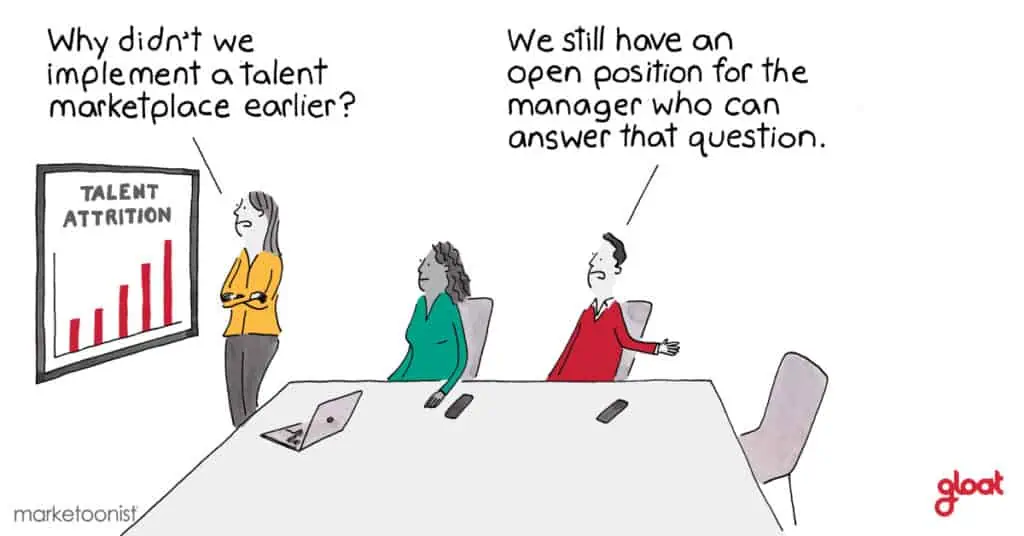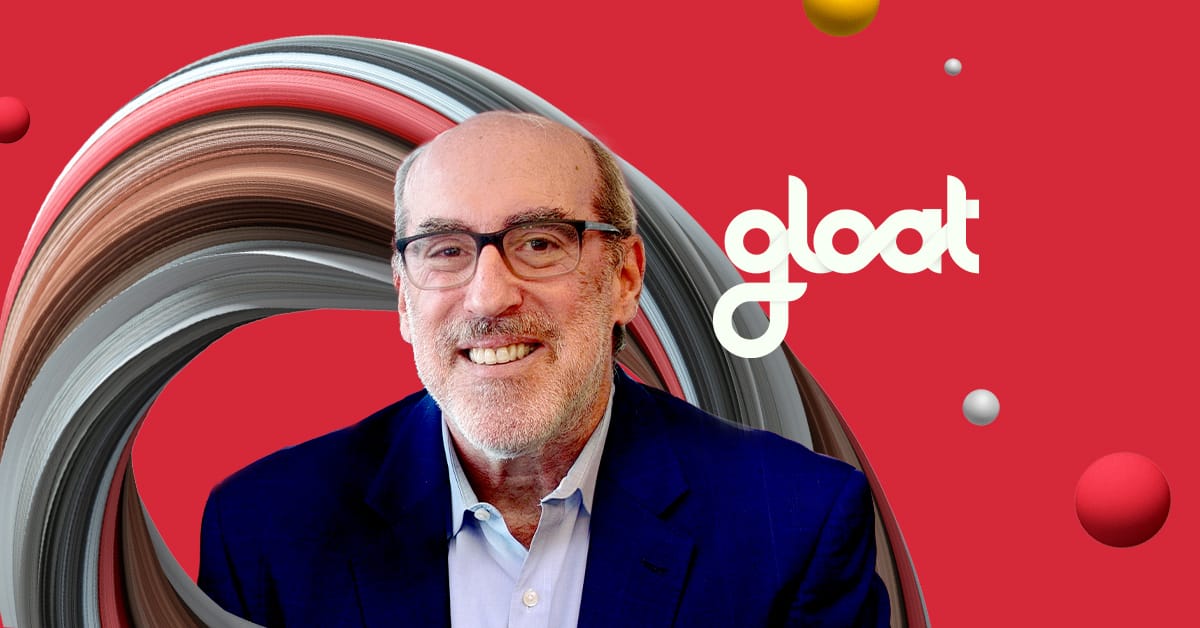Why every business needs to launch a talent marketplace in 2022
Zooming in on the bold changes that will set apart tomorrow’s winners

Across every industry, region, and sector, businesses are at the same crossroads: leaders need to decide whether they will stick with tried-and-true strategies or adopt new mindsets and emerging operating models.
It may feel like a risky choice, but pivots are paying off. When COVID-19 caused advertisers to cut budgets, Spotify embraced original content and became the podcast tastemaker. Over the same time period, Nestlé leveraged newly developed “ghost kitchens”—commercial kitchens where food is prepped for delivery—to safely meet consumers’ taste preferences.
You don’t have to look far to know our working world is changing faster than ever. The Great Resignation turned the employee-employer relationship upside down. Rapid digital innovation shrunk the half-life of skills. And the rise of hybrid work means leaders need to reimagine offices and the purpose they serve.
Given these changes, businesses can’t afford to stay the same. They must evolve to keep pace, which means embracing new operating models and the disruptive tools that can bring these frameworks to life.
Changing the Game with Talent Marketplaces
At this moment, the ball is in your court. Yet the window of opportunity to enact the structural changes demanded by the new world of work is quite small because your competition is focusing on the exact same thing. So what can you do to set your business up for success?
Take a page from agile organizations like Spotify and Nestlé. Both enterprises are harnessing disruptive technology to accelerate response times and fast-track innovation. To unlock agility and enable fast and smart pivots, they’re turning to the talent marketplace.
It’s not just pioneering brands that are taking note of this emerging technology. Deloitte recently spotlighted talent marketplaces as a platform that “is leading to wins at a time when organizations have to scale and flex their talent models to meet the needs of both the business and their workforce.” Gartner even named launching an internal talent marketplace as one of the three key focus areas to drive value in 2022.
In light of these endorsements, talent marketplaces are quickly gaining traction. Yet, too many organizations are leaving these platforms on their roadmaps, instead of taking advantage of them today.
It might feel like a safer move, but in our ever-changing world, no one wins by playing it safe. Tomorrow’s leaders won’t be the companies that decided to wait and see; they’ll be the businesses that made bold changes and forged new paths. And this starts with embracing game-changing technology.
The Unmatched Costs of Employee Turnover
By now, every executive knows the Great Resignation is much more than a blip on the radar. It’s not just a turnover tsunami; it’s a turn in the tides for work and workforces.
After months of record-high quit rates, it’s easy to understand why many organizations are struggling to keep profits and output levels high. When employees leave, as much as 84% of their salary is lost. In addition to the vacancies you’ll need to fill, turnover also creates knowledge gaps that slow efficiency levels to a halt.
To retain and engage your people during the Big Quit, you need to understand what’s driving the Great Resignation. It’s not just about money or better benefits; access to opportunity sits at the heart of today’s turnover crisis. In fact, a lack of growth opportunities is the second most common reason employees call it quits.
Consequently, internal mobility moves the needle most when it comes to retaining talent. Not only is hiring outside of your organization 1.7X more costly, but it can also send the wrong message to your people, who want to feel confident that their future with your business is bright.
Instead of just telling them that, why not show them? Deploying a talent marketplace through which employees can visualize potential career progressions within your organization shows them that this isn’t merely theoretical. Offering career pathing— which develops next steps to align employees’ ambitions with business priorities is how today’s visionary HR leaders truly walk the talk.
When Schneider Electric discovered that more than 50% of exiting employees cited a lack of internal growth opportunities as their primary reason for leaving the business, the enterprise quickly took action. To date, their talent marketplace has not only generated a savings of $15M in unlocked hours and reduced recruiting expenses; it also serves as a safeguard against the Great Resignation.
As their VP of Digital Talent Transformation, Jean Pelletier, explains, “Right now, what I will tell you, especially with the Great Reshuffle and the Great Resignation, is that we’re holding steady. And that’s super important to know.”
Talent Mobility as Fuel for Innovation
Natural disasters. Geopolitical crises. Cyberattacks. Global pandemics.
In a world of diverse risks and unprecedented volatility, innovation isn’t an advantage; it’s a prerequisite. When news of the pandemic broke, pharmaceutical companies were tasked overnight with fighting a disease researchers knew very little about. Less than a year later, these businesses began producing mRNA vaccines that have proven to be incredibly effective.
At the same time, the automotive industry answered a call for innovation that was equally high stakes. General Motors, Ford, and Tesla pivoted from manufacturing cars to making ventilators.
The need for rapid innovation won’t subside in the aftermath of COVID-19. As new risks emerge and consumer preferences change, businesses must be able to quickly iterate and conquer ever-evolving challenges. We’re already seeing it happen today, as the pressure to cut emissions drives oil companies to embrace renewable energy and retailers reroute deliveries in response to supply chain bottlenecks. Other major disruptions such as digitizing entire workforces, switching to green energy, or merger and acquisitions also call for agile and fast adaptation in order to be successful.
How can you unlock the innovation that will set your business apart? Traditionally, rigid hierarchies have created a breeding ground for organizational silos that slows response times, limits creativity, and delays product launches. Lately, groundbreaking models such as workforce pixelation highlight talent mobility as the fuel to innovation. By increasing the visibility of both skills and talent, talent marketplaces act as a powerful antidote to silos and in some cases, the ultimate innovation accelerator, as Unilever and Nestlé demonstrate.
During COVID-19, consumer brands needed to shift to prioritize key segments of their business, such as personal hygiene products and surface cleaners, and adapt operating models to keep both their consumers and their employees safe. To pivot, Unilever launched a “Raise a Hand, Lend a Hand” campaign powered by their talent marketplace. Within the first two months of the pandemic’s onset, the platform was used to staff more than 700 business-critical projects and unlock more than 26,000 hours.
At the same time, Nestlé embraced innovations like ghost kitchens to provide high-quality takeout and delivery experiences that met COVID-19 safety standards. In describing the enterprise’s move to embrace risk-taking and fuel creativity, Steve Presley, chairman and CEO of Nestlé USA, explains, “We needed to change how we work. And as part of that, we created new platforms to unleash our collective intelligence and bring new ideas to bear faster.”
Survival of the Most Agile
COVID success stories like the mRNA vaccines and ventilators aren’t just about innovation; they also underscore today’s need for speed. Simply devising an innovative solution is no longer enough to be successful; instead, businesses must also act quickly to respond to challenges in real-time.
If you think that sounds like a daunting undertaking, you’re not alone. While most organizations desire to achieve greater agility, structural inefficiencies are holding them back. Without full visibility into your workforce’s skills and capabilities, it’s impossible to deploy talent fast enough to meet today’s pace of change.
So what does it take to keep up? Leaders who succeed look beyond what employees are currently doing in their jobs and see their people for their full potential. Talent marketplaces use skills and ambitions as their main currency to match employees to relevant opportunities—in turn, uncovering key competencies that were previously untapped. Yet, once you have a full picture of what your workforce can achieve and a robustly built AI to streamline data and suggest connections, reallocating talent to meet emerging challenges becomes a lot more feasible.
One such success story is that of global data storage leader, Seagate. When the enterprise needed to pivot to achieve business resilience during the COVID-19 pandemic, they looked to their talent marketplace to initiate a large-scale redeployment that would underpin sustained growth without a change in headcount. “We realized we needed to lift and shift our resources to a new area of business to grow,” Chief Human Resources Officer Patricia Frost explains.
Within months, the business’s redeployment journey was successfully underway. “At one point we were doing up to almost two redeployments a day, or running a redeployment and then filling these projects. And I will tell you, we have gotten tremendous positive feedback from our employees about the projects they have worked on.
Unilever is another enterprise that has turned to agility to get ahead in the new world of work. As their CEO, Alan Jope, notes, “Agile ways of working are allowing us to redeploy both temporary and permanent resources to support our strategic priorities. Our Internal Talent Marketplace has helped us to re-prioritize 500,000 worker hours towards more than 3,000 business-critical projects.”
Equity and Diversity Set Organizations Apart
After workplace tensions built under the surface for decades, COVID-19 and our years of cultural reckoning are shining a much-needed spotlight on Diversity, Equity, Inclusion, and Belonging (DEIB). Today’s leaders understand that they must enact foundational changes to traditional organizational and managerial practices to meet this moment. 43% of CEOs now count building a diverse, equitable, and inclusive workforce as one of their top challenges.
While promoting meaningful DEIB initiatives may be challenging, it also has the potential to transform every aspect of your business. It will draw top talent towards your organization since more than 3 out of 4 employees consider diversity and inclusion when deciding where to work. There is also a strong correlation between diversity and improved financial performance. Not to mention that a combined focus on diversity and inclusion yields the highest levels of employee engagement.
In the past, many organizations released statements and conducted surveys, but few would go beyond the exploration stage and take action. As a result, workers would eventually lose faith in their employer’s ability to make a meaningful impact. In fact, Deloitte found that both sincere commitment and collaborative action are needed to gain and maintain trust in DEIB commitments.
Leaders must act now if they want to build trust and make real strides towards lasting change. Rather than looking to superficial measures like quotas, talent marketplaces help executives get to the root of the problem. They challenge existing structures and bias-prone cultures that make career advancement about who you know or easily relate to.
Talent marketplaces mitigate bias by increasing the visibility of opportunities and talent and bringing these two together using ethically constructed AI. As a result, talent marketplaces enable leaders to uncover high potential employees who may have been overlooked and equalize access to career growth and development opportunities.
Perhaps counterintuitively, when compared to most skin-deep DEIB initiatives, deploying a talent marketplace is a faster way to drive lasting impact. You don’t need to wait months, or even weeks, to see the effect of a talent marketplace on equity and inclusion.
Divikiran Kathuria, Director of Talent Mobility and Talent Technology at Seagate, tells the following story to illustrate how their platform immediately helped the organization make strides towards creating a culture of “talent without borders”.
When I opened a project for the first time on our talent marketplace, I ended up having a team from across the globe that help me bring in the local context to our internal communications plan,” she explains. “None of us were from a primarily English-speaking country and despite that, we worked beautifully together. And I could have never thought of those cultural and local nuances alone.
Retention on Cruise Control
It’s no secret that most businesses are grappling with a labor shortage. There have been months of sub-par jobs reports, quit rates that consistently break records, and headlines about the desperate lengths employers are going to convince their people to stay.
As a result, the war for talent is starting to look like a losing battle. How can you possibly accelerate launch times, devise innovative products, and transform your workplace culture if you can’t even hold on to the talent you need to keep your organization running?
Fortunately, it’s not too late to turn things around. You don’t have to surrender and accept labor shortages and ever-widening knowledge gaps as your business’s fate. By increasing the visibility of opportunities and empowering employees to take ownership of their career progression, talent marketplaces can become your secret weapon during the Great Resignation.
Launching a talent marketplace shows your people that you’re taking their growth seriously. It also ensures that you’ll have the talent needed to tackle tomorrow’s challenges. The visionary enterprises that are already utilizing talent marketplaces have seen the power of this message firsthand. As Patricia Frost explains,
We haven’t seen the Great Resignation at Seagate. The game-changer for us is this journey we’ve been on with Gloat. Employees have their careers in their hands and they can see vertical and lateral possibilities.
Nestlé’s VP and Head of HR, Laurel Catlett-King, summarizes a similar sentiment with one powerful question: “Who wouldn’t want to work in an organization that enables talent development and talent acceleration through a platform like Gloat?”
How Talent Marketplaces Will Transform Work and Workforces
Ultimately, the choice is simple. Enterprises needed to embrace new ways of working if they want to unlock the agility they’ll need to survive.
The only way to set yourself up for success in the new world of work is by making bold changes and harnessing disruptive technology to bring these transformative visions to life.
There’s no doubt that implementing a talent marketplace is a bold decision. The technology is nothing like the Human Capital Management Platforms people leaders used to rely on. Those tools were built for an old world of work that valued stability and predictability. In contrast, talent marketplaces are built for times of change. They’re designed to unlock agility and empower leaders to execute—rather than administrate.
They might even create some sense of upheaval, because, as Jean Pelletier explains, “It’s a complete rewrite of HR. You need to think differently about speed and how you go deep and broad in an organization using AI. It’s an absolute game-changer.”
But since the foundation of our world has been disrupted, we’ll need to evolve to keep pace. Right now, leaders have a small moment in time to reshape careers and adapt to this new pace of work. It’s the choices you make today that will determine whether you’ll look back at this moment as a missed opportunity—or a transformational turning point.
If you’re ready to outpace your competition, get a demo.





